Hand, Foot, and Mouth Disease is a viral infection that commonly occurs in young children and can easily lead to large outbreaks, yet there is no specific treatment available. Young children who do not receive timely treatment may experience serious complications.
Understanding Hand, Foot, and Mouth Disease
According to Dr. Huỳnh Minh Tuấn from the General Internal Medicine Department at Ho Chi Minh City University of Medicine and Pharmacy, hand, foot, and mouth disease is a common viral infection in infants and children under 5 years old, but it can also occur in adults. The disease occurs year-round, with peak periods around February to April and September to December.
The disease typically begins with fever, loss of appetite, fatigue, and sore throat. About two days later, painful sores appear inside the mouth and throat. Small red spots blister and break open into ulcers on the tongue, gums, and inner cheeks. A rash may develop two days later on the hands, feet, and sometimes the buttocks. The blisters on the skin are oval or slightly round, measuring 2 to 10 mm in diameter, raised or flat on a red base, painless, and when they dry, they leave behind pigmented marks. Many cases may only show rash or sore throat symptoms.
Patients can encounter severe complications such as meningitis, encephalitis, myocarditis, pulmonary edema, or a polio-like syndrome. These complications have a high mortality rate and progress very quickly, potentially within a single day.
The disease spreads from person to person through direct contact, most commonly through hands and contaminated surfaces. The incubation period is 3 to 7 days. Infected individuals are most contagious during the first week, and the virus can remain in the environment for weeks afterward. During an outbreak, children may experience recurrent infections until they are completely immune after the age of 5.
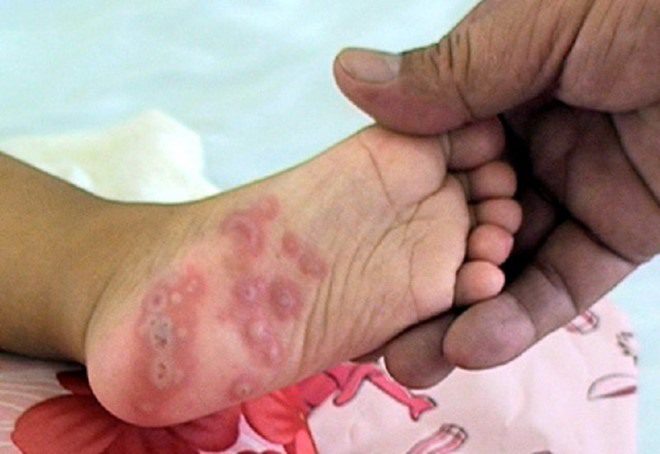
Blister symptoms on the sole of the foot in hand, foot, and mouth disease. (Photo: Health Life)
Symptoms of the Disease
Symptoms of hand, foot, and mouth disease usually appear within 3-5 days after exposure to the infection, during which time is referred to as the incubation period.
Early symptoms of hand, foot, and mouth disease include:
- High fever – typically around 38-39°C.
- Loss of appetite.
- Cough.
- Abdominal pain.
- Sore throat.
Sometimes, hand, foot, and mouth disease can cause vomiting, especially if caused by the enterovirus 71 strain.
These early symptoms may last for 12-48 hours.
Oral ulcers: After 1 or 2 days, red spots begin to appear in the mouth, especially around the tongue, gums, and inner cheeks.
Initially, these spots are the size of small buttons. They quickly develop into larger ulcers that are yellow-gray in color, surrounded by a red ring. Typically, there will be 5-10 lesions in the mouth.
These lesions can be very painful, making it difficult for children to eat, drink, and swallow, causing significant discomfort and crying.
These oral ulcers will heal within 5-7 days.
Skin rash: Shortly after the oral lesions appear, small red spots will be seen on the child’s skin.
The most common sites for these spots are the fingers, palms, soles of the feet, and occasionally the buttocks and groin.
These spots are approximately 2-5 mm in size, with a darker gray center and an oval shape.
These spots are usually painless and non-itchy, although they can develop into small blisters that sometimes cause pain and pressure. It is important not to burst these blisters, as it can lead to further spread of the disease.
The rash and blisters can last up to 10 days.
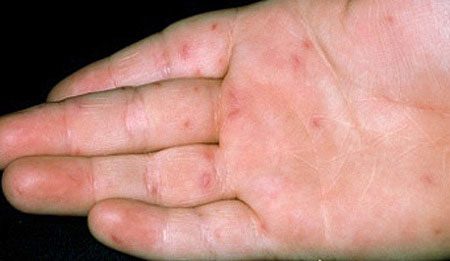
Do not burst these blisters, as it can lead to further spread of the disease
Causes of Hand, Foot, and Mouth Disease
Hand, foot, and mouth disease is caused by several types of enteroviruses, all belonging to the enterovirus A group. The most common types are coxsackievirus A16, A6, A10, and enterovirus 71.
First, the virus spreads to the tissues in the mouth, near the tonsils, and down to the digestive system.
Then the virus can spread to nearby lymph nodes and via the bloodstream throughout the body. The immune system responds to the virus to prevent it from spreading to vital organs, such as the brain.
How is the Disease Transmitted?
The viruses that cause hand, foot, and mouth disease can be transmitted in two ways:
- Through respiratory droplets – similar to the transmission route of the flu.
- Through contaminated surfaces or waste (feces).
Typically, the disease spreads when hands contaminated with the virus from contaminated objects are brought close to the mouth or nose. It can also be transmitted by inhaling the virus through droplets suspended in the air.
The virus does not spread in this way once the infected person has no symptoms.
However, the virus can still be present in large quantities in the feces of infected individuals and may persist there for up to 4 weeks after symptoms have resolved.
Hand, foot, and mouth disease can be transmitted from contact with fluid from blisters or saliva of an infected person.
Differences Between Hand, Foot, and Mouth Disease and Other Illnesses
Many viruses can cause red spots and sores in the mouth—not just those that cause hand, foot, and mouth disease.
However, doctors can differentiate hand, foot, and mouth disease from other viral infections by:
- The age of the patient – hand, foot, and mouth disease is most commonly seen in children under 10 years old.
- The pattern of symptoms – symptoms begin with high fever and sore throat; then ulcers develop in the child’s mouth, followed by rash spots on the hands and feet.
- The appearance of the spots – these spots are smaller than chickenpox spots and typically have different colors, sizes, and shapes.
The diagnosis of hand, foot, and mouth disease can be confirmed (or ruled out) by using a cotton swab to sample the skin, throat, or rectum of the patient and sending it for testing. For children, stool samples may be used.
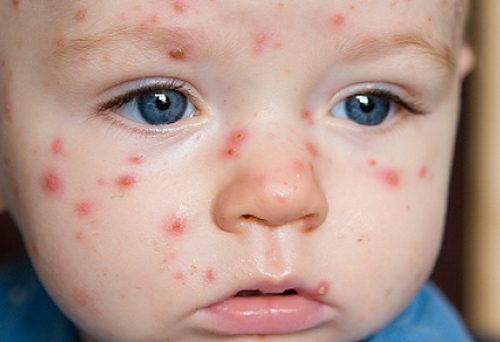
Chickenpox and hand, foot, and mouth disease have similar blister-like appearances. (Illustrative image: Internet).
Complications
Hand, foot, and mouth disease is usually mild and resolves on its own without treatment. Complications are rare but may include:
Dehydration
The sores in the throat and mouth can make it difficult to drink and swallow, leading to dehydration. It is crucial for children to stay hydrated. Encourage them to drink water and milk instead of acidic beverages like fruit juice.
It may be easier to encourage children to drink small amounts frequently rather than trying to drink a lot at once.
Contact a doctor if the child cannot or does not want to drink any fluids, or if the child shows signs of dehydration, including:
- Dry, wrinkled skin, especially when pinched, which takes a long time to return to normal.
- Inability to urinate, or no urine output in 8 hours.
- Crying without tears.
- Sunken eyes.
- The child appears unusually tired and lethargic.
- Sunken fontanel (in infants).
Cases of mild dehydration can be treated with oral rehydration solutions, available at most pharmacies. More severe cases may require treatment in a hospital.
Secondary Infections
There is also a risk of skin lesions becoming infected, especially if these lesions are scratched.
Symptoms of skin infections include:
- Pain, redness, swelling, and a feeling of warmth in the infected area.
- Skin weeping or purulent discharge.
Take the child to see a doctor if you suspect a skin infection, as they may need treatment with topical or oral antibiotics.
Viral Meningitis
In rare cases, hand, foot, and mouth disease can lead to viral meningitis. Viral meningitis is less severe than bacterial meningitis and does not pose a significant threat to health.
Most children will make a full recovery within 2 weeks.
Symptoms include:
- High fever of 38°C (100.4°F) or more.
- Lethargy.
- Headache.
- Stiff neck.
- Light sensitivity.
There is no specific treatment for viral meningitis other than pain relief medication to alleviate symptoms.
Encephalitis
The most severe but rare complication of hand, foot, and mouth disease is encephalitis, which can cause brain damage and threaten life.
Early signs of encephalitis resemble flu symptoms, which may develop within hours or days.
Other symptoms include:
- Fatigue.
- Indifference, lethargy, or confusion.
- Seizures.
- Weakness or paralysis of limbs.
- Light sensitivity.
- Other specific neurological symptoms.
Children with encephalitis require hospitalization for treatment.
Most cases of encephalitis associated with hand, foot, and mouth disease occur during large outbreaks caused by Enterovirus 71.
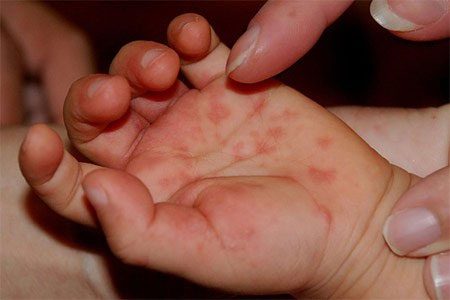
The most severe but rare complication of hand, foot, and mouth disease is encephalitis.
Treatment
There is no specific medication for hand, foot, and mouth disease. The illness typically resolves on its own within 7-10 days.
The disease is caused by a virus, meaning antibiotics cannot treat it. Antiviral medications are also ineffective in treating hand, foot, and mouth disease.
Symptoms in children can be alleviated by:
- Encouraging the child to rest and drink plenty of fluids (preferably plain water or milk; avoid acidic drinks like soda or orange juice).
- Feeding the child soft foods such as mashed potatoes and soup, as eating and swallowing may be quite difficult.
- Using medications to treat symptoms.
Medications
Over-the-counter medications such as paracetamol and ibuprofen can help relieve sore throat and reduce fever. Paracetamol is preferred over ibuprofen for pregnant women. Aspirin should not be given to children under 16 years old.
There are various gels, sprays, and mouthwashes available to treat mouth ulcers, although their actual effectiveness is unclear. These include:
- Lidocaine gel – can be used for children of all ages.
- Benzydamine mouth spray – suitable for children aged 5 years and older.
- Benzydamine mouthwash – suitable for children aged 12 years and older.
- Choline salicylate gel – only suitable for adults aged 16 years and older and should not be used by pregnant or breastfeeding women.
Be sure to read the instructions carefully before use, as these medications may only be used a few times a day.
Another method is gargling with warm salt water – mix half a teaspoon of salt (2.5g) with 1/4 liter of water. It is important not to swallow, so this method is not recommended for young children.
If the child has blisters, avoid popping them as the fluid inside can spread the disease. The blisters will dry and heal within 7 days.
Maximize Isolation of Infected Children
When a young child is diagnosed with the disease, Dr. Truong Van Quy, Head of the General Pediatrics Department at E Hospital (Hanoi), advises parents to remain calm to manage the situation effectively. Typically, cases exhibiting level 1 symptoms can be cared for at home. However, parents should take the child to see a doctor immediately if they have a fever or rash for a comprehensive evaluation to determine the severity.
Additionally, we must ensure personal hygiene, washing hands frequently with soap and disinfectant. Upon returning home, adults should wash their hands and change clothes before interacting with and caring for the child.
“When a child is diagnosed with the disease, they must be isolated as much as possible and not allowed to come into contact with other children. Parents should keep the child home from school and notify the local disease prevention center for disinfection and prevention measures,” Dr. Quy emphasized.
When to Seek Medical Attention?
Most cases of hand, foot, and mouth disease do not require hospitalization as symptoms resolve within 7 days without treatment.
However, if you are unsure whether the child has hand, foot, and mouth disease, you can take them to see a doctor.
You should also contact a doctor if:
- The child cannot or refuses to drink any fluids.
- The child shows signs of dehydration, including not urinating as frequently as usual.
- The child’s symptoms do not improve or worsen after 7 days.
- The child exhibits additional symptoms, such as changes in mental status, seizures, or behavioral changes.
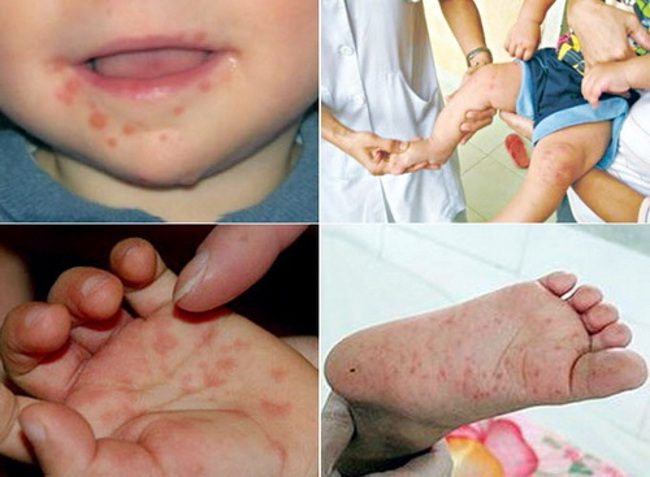
Good personal hygiene helps prevent hand, foot, and mouth disease.
Preventing Disease Transmission
Hand, foot, and mouth disease is highly contagious. The best way to avoid contracting and spreading the disease is to avoid close contact with infected individuals and
- Always wash hands after using the restroom or changing a child’s diaper, and before preparing food.
- Encourage sick children to wash their hands frequently.
- Avoid sharing utensils with infected individuals.
- Ensure all surfaces are kept clean.
- Wash bedding or clothing that may have come into contact with saliva, fluid from blisters, or feces in hot water.
For workplaces, schools, and daycare centers
If a child has hand, foot, and mouth disease, they should stay home while they feel unwell.
Children can return to school as soon as they feel better. There is no need to keep them out of school until the last blister has healed, as all blisters will eventually heal.
However, this is just advice. Each school and childcare facility may refuse to accept a child until they are completely well.
These recommendations also apply to adults with hand, foot, and mouth disease who want to know when they can return to work.


















































